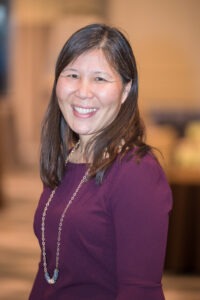 Workforce Matters is a national network of grantmakers that works to strengthen workforce development philanthropy and advance equitable education and employment outcomes for young people and adults. As part of this work, the network launched the Fund for Workforce Equity, a pooled fund designed to spark innovative strategies to center workers and learners of color in the design and implementation of workforce policies and programs. The Fund, which is now working with its inaugural group of 15 grantees, was sparked by the Racial Equity Framework for Workforce Development Funders, a game-changing tool Workforce Matters developed in 2021 that helps funders successfully work toward racial equity in their programs.
Workforce Matters is a national network of grantmakers that works to strengthen workforce development philanthropy and advance equitable education and employment outcomes for young people and adults. As part of this work, the network launched the Fund for Workforce Equity, a pooled fund designed to spark innovative strategies to center workers and learners of color in the design and implementation of workforce policies and programs. The Fund, which is now working with its inaugural group of 15 grantees, was sparked by the Racial Equity Framework for Workforce Development Funders, a game-changing tool Workforce Matters developed in 2021 that helps funders successfully work toward racial equity in their programs.
We sat down with Loh-Sze Leung, director of Workforce Matters, to talk about the Fund and why specific aspects of the American economic landscape make efforts like this vital.
Q: How did the Fund for Workforce Equity get started, and what are its goals?
The Fund for Workforce Equity is our first collaborative grantmaking effort, and we launched with pooled funding from 22 grantmaking organizations. Our first round of grants focused on engaging workers and learners of color in developing, forming and implementing workforce programs and policies. We want learners and workers of color in particular to have a voice and agency in shaping the programs and services that are often designed for them and with them in mind, but not necessarily with them at the table.
The Fund grew out of the racial equity framework we published two years ago that focused on the ways that workforce grantmakers can advance equity in their grantmaking practice. A number of funders who were engaged in the development of the framework came to us after the framework was launched and were excited to invest in some of the ideas we wrote about and put them into practice.
Our advisory committee is made of a combination of these philanthropic leaders and workforce field leaders committed to interrupting the systemic racism embedded within the field’s practices, policies, programs and the labor markets of communities they serve.
Q: What are the greatest challenges facing workers today? What are unique challenges facing younger workers and learners?
This is a time of really rapid change — especially with the digitalization of work and the impact of technology on work. I don’t think that’s a new thing, but I think the pace at which things are changing has quickened. The pandemic and shifts to both virtual and hybrid learning and working exacerbated existing inequities. And the pace of this change is outstripping the pace at which many of our education and training organizations and institutions can pivot to meet the evolving needs of workers, learners and employers. This can result in disparities growing even wider.
In addition, over the last few decades, worker power to determine the conditions of their work has really eroded. There has been a kind of disinvestment in workers, in their skills, in their advancement and in their longevity in many organizations. The concentration of ownership and capital in this country make this problem even worse. You are starting to see some examples where workers are starting to see that they have the ability to organize and push back, but those examples are still few and far between. Again, as we saw during the pandemic, there is also a disconnect between what we consider to be essential work and how we pay for that work, and due in large part to systemic racism leading to occupational segregation, many workers of colors are over-represented in these low-paying yet essential jobs.
Q: How does the Fund address these challenges?
Launching the Fund for Workforce Equity, with a focus on workers and learners of color, put a stake in the ground around the importance of starting with and supporting efforts to center worker voice. We are grateful that so many funders joined us in our first year, and that so many organizations — nearly 400 in total — responded to our first RFP.
Out of this pool, we selected a group of 15 workforce development organizations representing a range of geographies, populations, industry sector efforts, and approaches to workforce development. Each grantee organization is receiving up to $75,000 in flexible funding to implement initiatives that center workers and learners of color in designing or implementing workforce policies and programs. They are:
- Alternatives For Girls Detroit, Michigan
- California Indian Manpower Consortium Sacramento and San Diego County, California
- Chicago Commons Association Chicago, Illinois
- Encuentro Albuquerque, New Mexico
- Fair Work Center Seattle and Yakima Valley, Washington State
- Gideon’s Army Grassroots Army for Children Nashville, Tennessee
- Hack.Diversity Boston, Massachusetts and New York City
- Hired Minneapolis, Minnesota
- Insight Garden Program (IGP) Berkeley, California
- New York Association of Training and Employment Professionals (NYATEP) Albany, New York
- Cafe Reconcile (RNO) New Orleans
- Rocky Mountain Partnership (RMP) Thornton, Colorado
- Roots Community Health Center Oakland, California
- YWCA San Antonio San Antonio, Texas
- Youth Opportunities Unlimited (Y.O.U.) Cleveland, Ohio
Beyond grantmaking, the Fund is also supporting a learning community, technical assistance, and a learning and evaluation effort. We hope to learn more about how to effectively make space and create conditions for workers and learners of color to exercise their agency and voice and power in workforce development. And we hope to grow the number of organizations and funders doing this work. It’s as much a kind of data collection and amplification effort as it is a grantmaking effort.
Q: What are you learning so far, now that you’re halfway through the first grant cycle?
We are seeing some really exciting work starting to happen on the ground. Grantees are working to gather and respond to feedback from participants and alumni; they are forming advisory committees comprised of participants and graduates; they are building the capacity to do participatory and participant-led research; and they are even starting to change their approach to programming based on early feedback.
It’s still early to share many outcomes, given that grantees have really been implementing projects for about six months, but here are a few lessons learned that our grantees have shared with us as funders:
- Take the time to build relationships and trust with workers and learners before jumping into what you thought you were going to do. Listening to what they need and responding to those needs will help to create a space where people feel like they are heard and will build their willingness to provide feedback and engage in program development.
- As much as you are preparing workers and learners to lead and provide feedback, you also have to be intentional about preparing your own staff, partners and other leaders to share power and work alongside community members with lived experience.
- Listen, listen, listen. Our grantees all entered this work with a plan, and almost all of them have had to pivot for various reasons, including getting feedback from workers and learners about what was working and what wasn’t about the plan. Making adjustments in response leads to higher and more sustained engagement in the work, and ultimately stronger programs that better meet the needs of workers and learners.
Finally, this work takes time and resources. And that’s an important lesson for funders to keep in mind. We can’t just assume that this engagement will happen without also resourcing it. And we need to hold realistic expectations for the timeline and outcomes of the engagement that are in line with the resources we are providing to support it.









Comments